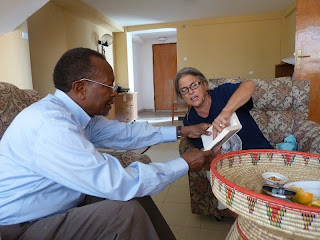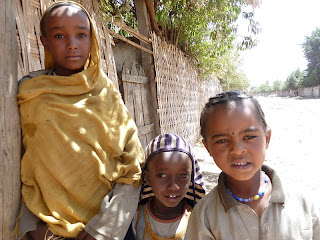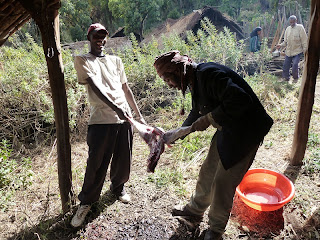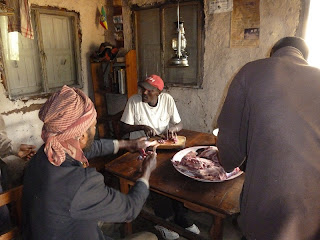February
11, 2012
Greetings
from Hawassa!
With
sore rhomboids, hip adductors and tuchases,
but otherwise intact, we return from the Bale Mountains after a 3-day
horse trek through some of the most lovely parts of Ethiopia.
We
had not planned this trip, but both of us had taken leave from our
work in order to travel south to Kenya to visit Elliot's adopted
brother, Kanikis, in Marsabit District. This is the son of Lekati,
the Samburu Laibon who adopted Elliot more than 35 years ago, and
Elliot has stayed in touch with him through the death of Lekati,
Kanakis' initiation into manhood, marriage and beyond. We were to
have left for Kenya last Thursday, but then found out that we both
had to have yellow fever shots at least 2 weeks before crossing into
Kenya, and El hadn't been able to secure one in Addis Ababa until
January 31. So, we had to do something else while the yellow fever
“cooked”. We had eyed the Bale Mountains, about two hours to the
east, and their locally-run eco-tourism trekking and decided to give
it a go, both of us with some hesitations about accessibility and our
own durability. And then the day before we left, Marty was hit with
some miserably sick patients who left her feeling at a loss with
their care, adding a sense of irresponsibility to the mix. She also
had a wicked cold, but we went anyway. And we are both glad we did.
We
will post a map of Ethiopia with our pics, because it may help. Our
fellow Fulbrighter Assefa and his family visited us from Bahir Dar
and kindly drove us the 25 kilometers to Shashomene (known as the
town where Haile Selassie allowed Jamaican Rastafarians to settle, a
settlement that still remains). From there we took a mini-van packed,
as always, with eighteen people (in a van fit for 12!) for 67
kilometers to the town of Dodola at the base of the Bale Mountains.
We located the Bale Mountain Hotel and checked in, expecting to spend
the night there. But within 15 minutes of finding a room we were
visited by Abdul, a guide from the Eco-Trekking cooperative, because
Elliot had mentioned to the hotel staff that we were looking for its
office. Abdul immediately a) said that we could go that afternoon; b)
picked up a few supplies and c) started walking uphill with us. It
was c. that presented a problem. Uphill. Usually the treks are by
horseback but the abrupt start of ours meant that we were going to
walk “only 11 kilometers” uphill that afternoon. Abdul sussed us
up fairly quickly (and El's comment that 11 kilometers seemed awfully
long in between puffs probably helped) and hailed a horse-cart
driver-friend who took us in his cart up the first 5 kilometers and
we walked-climbed the rest of the way. All we can say is that we
didn't die.
The
land closely resembles Montana or Wyoming, with dryland grain farming
and pasture-lands below the high mountains. It is populated by Oromo
people who have been herding, traveling and fighting by horseback for
centuries. It was the Oromo cavalry that beat back the Italians at
Adwa in 1896, humiliating them thoroughly in one of the few African
victories over European colonialists. They are striking people. Most
on Bale are Muslim and, though many wear western suits, on their
heads are turbans, creating a glorious picture as they gracefully
canter and gallop over the hills or by the roadside. The women dress
in dark long dresses and walk their pack-horses carrying water and
goods for the market the many miles to Dodola. The houses have round
straw-thatched roofs and animal corrals are made of intertwined
branches and vines and in between children herd the goats, cattle
and sheep. It is a very specifically Ethiopian Montana that often
took our breath away. People seemed solemn but as soon as we greeted
them with Oromo “Nagaa!” or even Amharic “Salaam!” their
smiles would light our way.
That
was the foothills. Then we climbed (with every one of our muscles
protesting) into the forested mountains. The main tree species is the
Ethiopian juniper, with large trunks and weeping needle-covered
branches. The undergrowth is controlled by Oromo livestock that are
scattered throughout the mountains. The forest is gorgeous - cool,
green and quiet. We saw bushbuck (Ethiopian deer) and colobus monkeys
(the glorious black and white ones with long white tails, they swing
high in the forest canopy), a flock of wattled ibis and many pretty little unknown songbirds.
The
first night was spent in a tent in a camp named Changiti built by the German aid
agency GTZ, which actually does help local people make some money. We
aren't sure we could have made it another step, so were glad that
combined Oromo/German wisdom did not make the first camp 12
kilometers
rather than 11. We were on a mountain outcropping with valley on three
sides. And cold!
That
was not a sensation we had had (except for Marty's trip to the
States) in almost 5 months. The stars were glorious and the silence
was remarkable.
Next
morning we were up and in the saddle for three hours to another camp,
Wohoru, actually a house on an Oromo farm hamlet 10,000 feet high in the mountains
at the base of one of the tallest of the peaks. It was beautiful, but
the poverty and isolation of the people affected Elliot particularly.
People live off raising and selling onions and their sheep and
cattle. We asked the man who owned the farm what he made selling his
onions, and it was about $80 a year. The Eco-Trekking helps, and we
were conscious to buy a goat to be killed for tibs (an Ethiopian meat
specialty) knowing that we would eat a small amount, and the rest of
the meat and the money would benefit the 8-9 people living in this
small hamlet. We didn't do a whole lot – we arrived before noon,
and would spend the day there, so we read and took small walks, one
to an area where local people keep wild bees and harvest their honey
for confection and for Ethiopian honey wine, tej.
Marty
loved the beauty, but was affected not only by the poverty, but also
by the altitude and lack of caffeine. Ethiopians drink coffee all day
long in ceremonies but not to get out of bed in the morning, and we
somehow never managed to communicate to Abdul that we were useless
without morning Joe. A coke helped, something we rarely drink. Sleep
didn't come easily for Marty (in part because the high altitude,
above 10,000 took her breath away). But today's walk and horse-ride
back to Dodola were worth caffeine-withdrawal and altitude dyspnea. By
the way, we signed and scanned the visitor registration books at both
of the sites and found that very, very few of the trekkers were over
35. If we could move, we would do a little strut. But we can't.
Back
now to our lovely little 'guest house' apartment. We are about to go
out to eat with friend Lemma, who will soon leave for the States.
Just talked to Helen who assures us that there is no more snow on the
ground in Massachusetts and tomorrow we will prepare to go to Kenya.
Nothing
changes in our missing you. Friends and family have been great about
keeping us up to date. Please stay in touch.
 |
| Marty and Lemma comparing birding experiences. |
 |
| Children in Abdul's family in Dodola |
 |
| Guide Abdul |
 |
| Reading at first campsight, Changiti |
 |
| Unmarked gravestones at Changiti |
 |
| View of Oromo village in valley from Changiti |
 |
| One of Elliot's "Oromo cattle" series |
 |
| Saddling up to leave Changiti |
 |
| Elliot on horse, ready to go. |
 |
| Uphill on horse. |
 |
| Abdul trying to get the kinks our of Marty's shoulders. |
 |
| Children at Wohoru |
 |
| Marty among goats at Wohoru |
 |
| Very small goatherd at Wohoru |
 |
| Marty examining elderly blind man's eye, Wohoru. |
 |
| Preparing the goat. |
 |
| Further preparing the goat. |
 |
| Little boy chasing cow, Wohoru |
 |
| Getting ready to ride, Wohoru. |
 |
| It's really hard to take a picture while riding. |
 |
| Marty and Abdul |
 |
| Women winnowing in Dodola |
 |
| View out of our over-packed minivan from Dodola |
 |
| Washing the dust out of the undies. |
